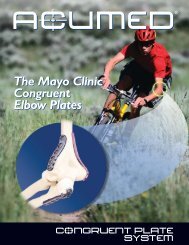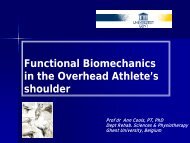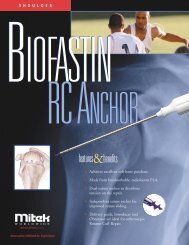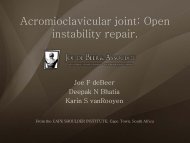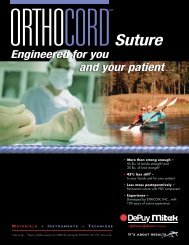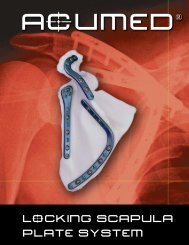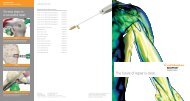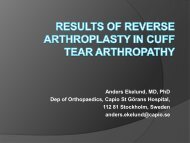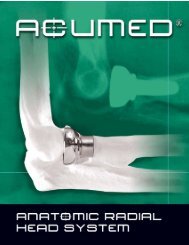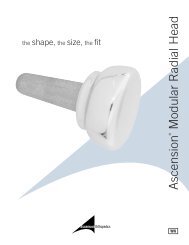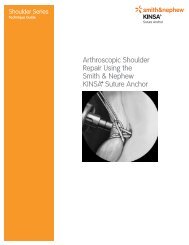Tornier Fracture Surgical Technique
Tornier Fracture Surgical Technique
Tornier Fracture Surgical Technique
Create successful ePaper yourself
Turn your PDF publications into a flip-book with our unique Google optimized e-Paper software.
POST OPERATIVE REHABILITATIONPostoperative rehabilitation is equally important after shoulder arthroplasty for a fracture case as it isfollowing shoulder arthroplasty for chronic etiologies, contributing at least 50% to the final outcome.Rehabilitation after prosthetic replacement of a 4 part proximal humerus fracture is perhaps the mostchallenging aspect of shoulder rehabilitation.In order to avoid complications such as hemarthrosis, hematoma, and prosthetic instability, it is recommendedto delay the postoperative rehabilitation until the tuberosities have healed, 45 to 60 days postoperatively.Because of frequent tuberosity fixation failure previously observed, the aggressiveness of postoperativerehabilitation has been reduced to avoid these potentially catastrophic complications. Early passivemotion is not recommended because it is easier to treat a stiff shoulder than a tuberosity migration ornonunion.The patient’s arm is immobilized in 45 degrees abduction and neutral rotation for a period of 4 to 6 weeks.During the first 3 postoperative weeks, active mobility of the hand, fingers and elbow is allowedwithout any movement of the shoulder joint.In the fourth postoperative week, after insuring the tuberosities have remained in place radiographically,passive abduction of the arm is permitted starting from a resting position of 45 degrees abduction. Norotation is allowed at this time as this could cause suture failure before the tuberosities have healed.At 6 weeks postoperative, passive rehabilitation is initiated emphasizing elevation and rotation. Thepatient sees a physiotherapist 3 times per week, but the patient, with the assistance of his or her family,carries out therapy exercises at home on days they do not see the therapist. Rehabilitation in a warmwater pool is particularly helpful when feasible from the 21st post operative day.Once the tuberosities clearly show radiographic healing (2 to 3 months postoperative), active mobilityis permitted in elevation and internal rotation. These exercises can be performed by the patient at homemany times during the day. Strengthening or resistance exercises are avoided as these can be responsiblefor pain and have shown no proven benefit.Experience with this rehabilitation protocol has demonstrated tuberosity migration and nonunion tooccur infrequently. Patients must be informed of the risk of postoperative stiffness during the first 6 to9 postoperative months. This stiffness invariably diminishes, provided the anatomy had been properlyreestablished. Final mobility is usually obtained by 12 months postoperatively.In summary, rehabilitation followinghumeral head replacement for fracturefocuses on obtaining union ofthe tuberosities.The postoperative radiographs showanatomical reconstruction of thehumerus using the Aequalis <strong>Fracture</strong>Solution.Pr. Pascal Boileau and Dr. Gilles WalchThe post operative Xrays shows a perfect anatomical reconstructionof the humerus thanks to the Aequalis-<strong>Fracture</strong> solution.25



